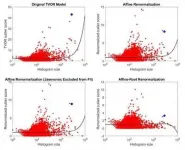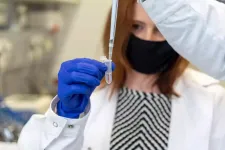(Press-News.org) HOUSTON - (June 29, 2021) - The story of halichondrin B, an inspirational molecule obtained from a marine creature, goes back to the molecule's discovery in an ocean sponge in 1986.
Though it has been replicated in the laboratory several times before, new work by Rice University chemists could make halichondrin B and its naturally occurring or designed variations easier to synthesize.
Synthetic chemist K.C. Nicolaou and his lab reported in the Journal of the American Chemical Society their success in simplifying several processes used to make halichondrin B and its variations.
Halichondrin's molecular structure and potent antitumor properties inspired the design and synthesis of variations (aka analogues). The Rice lab's "reverse approach" to make halichondrin B resulted in the shortest route to what the researchers referred to as a "highly complex and important molecule."
"This total synthesis represents the shortest of the previously reported approaches to this complex natural product," Nicolaou said. "Its importance lies in its potential for further improvement and application to the rapid synthesis of other members of the halichondrin family as well as novel designed analogues as potential drug candidates."
He said the Rice lab's technologies can in principle be applied to the production of eribulin, a simpler and powerful halichondrin B analogue clinically used to treat breast cancer and liposarcoma.
Previous and current syntheses of halichondrin B and its analogues require initial bonding of carbon atoms, and then bonding of carbon and oxygen atoms, to construct cyclic ethers, key building blocks essential to making the molecules.
Nicolaou and his colleagues flipped the sequence to make the carbon-oxygen connections first. Known as the Nicholas etherification, this process was followed by radical cyclization to form the required carbon-carbon bonds, finally coupling them en route to the targeted halichondrin B.
Nicolaou noted other labs have "flipped" the process to synthesize various simpler compounds, but none had tried it on halichondrin B. "Its importance as a biologically active molecule coupled with its synthetically challenging structure served as our motivation to pursue this project," he said.
Their work reduced the number of steps required to make the molecule to 25, starting from commercially available materials. Nicolaou expects further simplification, will not only further reduce the steps of the synthesis, but also improve the overall yield, resulting in a more efficient and cost-effective chemical process for making this type of compounds.
INFORMATION:
Co-authors of the paper are postdoctoral researchers Saiyong Pan, Yogesh Shelke, Dipendu Das, Qiuji Ye, Yong Lu, Susanta Sau and Ruiyang Bao, and research scientist Stephan Rigol, all of Rice.
Nicolaou is the Harry C. and Olga K. Wiess Professor of Chemistry and a Cancer Prevention and Research Institute of Texas (CPRIT) Scholar.
AbbVie Stemcentrx, CPRIT and The Welch Foundation supported the research.
Read the abstract at https://pubs.acs.org/doi/10.1021/jacs.1c05270.
This news release can be found online at https://news-network.rice.edu/news/2021/06/29/reversal-speeds-creation-of-important-molecule/
Follow Rice News and Media Relations via Twitter @RiceUNews.
Related materials:
Nicolaou Research Group: https://nicolaou.rice.edu/
Department of Chemistry: https://chemistry.rice.edu
Wiess School of Natural Sciences: https://naturalsciences.rice.edu
Images for download:
https://news-network.rice.edu/news/files/2021/06/0705_REVERSE-1-WEB.jpg
Rice University synthetic chemists have simplified the process to make halichondrin B, top, the parent compound of the successful cancer drug eribulin, bottom. Their reverse synthesis reduced the number of steps required to make the natural product. (Credit: Jenna Kripal/Nicolaou Research Group)
https://news-network.rice.edu/news/files/2021/06/0705_REVERSE-2-WEB.jpg
CAPTION: K.C. Nicolaou. (Credit: Rice University)
Located on a 300-acre forested campus in Houston, Rice University is consistently ranked among the nation's top 20 universities by U.S. News & World Report. Rice has highly respected schools of Architecture, Business, Continuing Studies, Engineering, Humanities, Music, Natural Sciences and Social Sciences and is home to the Baker Institute for Public Policy. With 3,978 undergraduates and 3,192 graduate students, Rice's undergraduate student-to-faculty ratio is just under 6-to-1. Its residential college system builds close-knit communities and lifelong friendships, just one reason why Rice is ranked No. 1 for lots of race/class interaction and No. 1 for quality of life by the Princeton Review. Rice is also rated as a best value among private universities by Kiplinger's Personal Finance.
Jeff Falk
713-348-6775
jfalk@rice.edu
Mike Williams
713-348-6728
mikewilliams@rice.edu
Dark Energy is widely believed to be the driving force behind the universe's accelerating expansion, and several theories have now been proposed to explain its elusive nature. However, these theories predict that its influence on quantum scales must be vanishingly small, and experiments so far have not been accurate enough to either verify or discredit them. In new research published in EPJ ST, a team led by Hartmut Abele at TU Wien in Austria demonstrate a robust experimental technique for studying one such theory, using ultra-cold neutrons. Named 'Gravity Resonance Spectroscopy' (GRS), their approach could bring researchers ...
Scientists have discovered how plants manage to live alongside each other in places that are dark and shady.
Moderate shade or even the threat of shade - detected by phytochrome photoreceptors - causes plants to elongate to try to outgrow the competition.
But in the deep gloom of a dense forest or a cramped crop canopy where resources and photosynthesis are limited, this strategy doesn't work. In these conditions it would be a waste of energy and detrimental to survival to elongate stems because seedlings would never be able to over-grow larger neighbours.
So how do plants prevent elongated growth under deep shade conditions? The secret lies in their internal clocks, says the research collaboration from the John Innes Centre ...
NEW YORK (June 29, 2021)--In a new paper published in the journal Vaccine: X, public health experts from Columbia University Mailman School of Public Health, the University of Oslo, and Spark Street Advisors highlight actions to accelerate access to vaccines globally. The paper reviews the vaccine research and development process and proposes areas where reforms could increase access, speed time to market and decrease costs--from R&D to manufacturing and regulation to the management of incentives like patents and public funding.
The COVID-19 ...
A process that uses heat to change the arrangement of molecular rings on a chemical chain creates 3D-printable gels with a variety of functional properties, according to a Dartmouth study.
The researchers describe the new process as "kinetic trapping." Molecular stoppers--or speed bumps--regulate the number of rings going onto a polymer chain and also control ring distributions. When the rings are bunched up, they store kinetic energy that can be released, much like when a compressed spring is released.
Researchers in the Ke Functional Materials Group use heat to change the distribution of rings and then use moisture ...
DURHAM, N.C. - Combining structural biology and computation, a Duke-led team of researchers has identified how multiple mutations on the SARS-CoV-2 spike protein independently create variants that are more transmissible and potentially resistant to antibodies.
By acquiring mutations on the spike protein, one such variant gained the ability to leap from humans to minks and back to humans. Other variants -- including Alpha, which first appeared in the United Kingdom, Beta, which appeared in South Africa, and Gamma, first identified in Brazil - independently developed spike mutations that enhanced their ability to spread rapidly in human ...
Aerospace engineering faculty member Melkior Ornik is also a mathematician, a history buff, and a strong believer in integrity when it comes to using hard science in public discussions. So, when a story popped up in his news feed about a pair of researchers who developed a statistical method to analyze datasets and used it to purportedly refute the number of Holocaust victims from a concentration camp in Croatia, it naturally caught his attention.
Ornik is a professor in the Department of Aerospace Engineering at the University of Illinois Urbana-Champaign. He proceeded to study the research in depth and used the method to re-analyze the same data from the United ...
ROCHESTER, Minn. -- Mayo Clinic researchers are taking a close look at rare cases of inflammation of the heart muscle, or myocarditis, in young men who developed symptoms shortly after receiving the second dose of the Moderna or Pfizer messenger RNA (mRNA) COVID-19 vaccines. Several recent studies suggest that health care professionals should watch for hypersensitivity myocarditis as a rare adverse reaction to being vaccinated for COVID-19. However, researchers stress that this awareness should not diminish overall confidence in vaccination during the current pandemic.
While reports of post-vaccine myocarditis ...
Using real-time deformability cytometry, researchers at the Max-Planck-Zentrum für Physik und Medizin in Erlangen were able to show for the first time: Covid-19 significantly changes the size and stiffness of red and white blood cells - sometimes over months. These results may help to explain why some affected people continue to complain of symptoms long after an infection (long Covid).
Shortness of breath, fatigue and headaches: some patients still struggle with the long-term effects of a severe infection by the SARS-CoV-2 coronavirus after six months or more. This post Covid-19 syndrome, also called long covid, is still not properly understood. What is clear is that -- during the ...
In two journal articles, a University of Houston biomedical researcher reports a step forward in diagnosing intestinal diseases, including colorectal cancer, ulcerative colitis and Crohn's disease using stool proteins. The current gold standard for colon cancer testing measures blood (hemoglobin) present in stool, and tests for inflammatory bowel disease (IBD) measure levels of calprotectin, a protein that detects inflammation in the intestines.
"The unique aspect of both research reports is that we are looking at stool samples comprehensively, ...
INDIANAPOLIS - Ten IU School of Medicine researchers out of a team of 11 scientists, are responsible for the findings of a new study they conducted to investigate alternative ways to treat kidney infections. Their work, which is published in the high-quality research journal Nature Communications, examined how to utilize the kidneys' own internal infection fighting capabilities to treat and even prevent kidney infections, with the knowledge that eventually antibiotics won't work.
According to statistics, urinary tract infections or UTIs are one of the most frequent bacteria-causing ...




